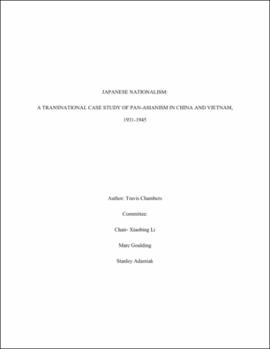| dc.description.abstract | After Japan pragmatized bushido and formed a modernized nation-state in the late nineteenth century, it extended that same methodology to its East Asian neighbors, China and Vietnam. Despite state-sponsored bushido's success at home and cultural similarities with Asian peoples abroad, Japanese nation-state building failed in China and Vietnam. Was Pan-Asianism fully implemented as designed by Japanese architects? What were the repercussions of Pan-Asianism on nationalist movements in East Asia? Previous scholarship addressed these questions unfairly and critiqued Chinese and Vietnamese nationalists, who accepted Japanese aid, as collaborators or traitors. Additionally, historiography abruptly demarked Pan-Asianism's demise at Japan's surrender in 1945. Japanese nationalism and state-building succeeded in Japan but when applied transnationally from 1931-1945 and despite social, linguistic, and cultural similarities, Pan-Asianism failed in China and Vietnam due to differing historical experiences. This is an intellectual history that comparatively analyzes rhetorical, cultural, political, educational, economic, and military exchange between Japan, China, and Vietnam. Furthermore, it is a new interpretation of Pan-Asian exchange during World War Two that utilizes a transnational lens. It relies on primary sources from Japan, China, Vietnam, Great Britain, France, the United States, and numerous other countries involved from 1931-1945. The author does not simply employ sources from various countries but explains scholarly interchange and the formation of national narratives within East Asia. Moreover, the author references secondary sources from previous scholarship to establish a background and contribute a more rounded historical narrative. The author illustrates that despite cultural, linguistic, and social similarities between Japan, China, and Vietnam, Pan-Asianism was not effectively transplanted due to differing historical circumstances. The Japanese nation formed as a military culture and remained isolated from the seventeenth to nineteenth century. Japanese national-formation was juxtaposed to that of China and Vietnam, both of which were subjected to external incursions, consisted of various ethnic groups, and had different dialects. Despite Japan's failure in implementing Pan-Asianism directly, aspects of it survived World War Two into the Cold War in the form of post-colonial, nationalist movements in East Asia. This significantly contributes to historiography as a new, comparative study and intellectual history through a transnational lens. | |
